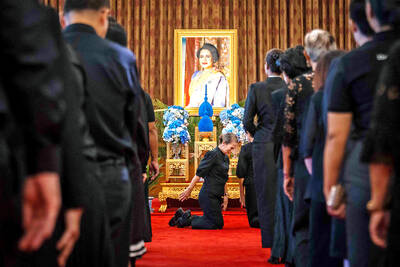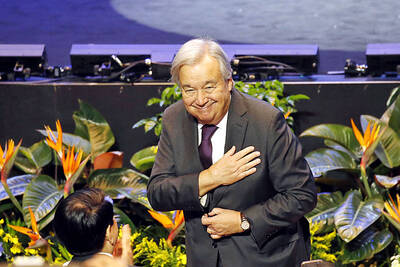Has Winnie the Pooh done something to anger China’s censors? Some mentions of the lovable but dimwitted bear with a weakness for “hunny” have been blocked on Chinese social networks.
Authorities did not explain the clampdown, but the self-described “bear of very little brain” has been used in the past in a meme comparing him to portly Chinese President Xi Jinping (習近平).
Posts bearing the image and the Chinese characters for Winnie the Pooh were still permitted yesterday on Sina Weibo.
However, comments referencing “Little Bear Winnie” (小熊維尼) turned up error messages saying the user could not proceed because “this content is illegal.”
Winnie the Pooh stickers have also been removed from WeChat’s official “sticker gallery,” but user-generated GIFs of the bear are still available on the popular messaging app.
Comparisons between Xi and Pooh first emerged in 2013, after Chinese social media users began circulating a pair of pictures that placed an image of Pooh and his slender tiger friend Tigger beside a photograph of Xi walking with then-US president Barack Obama.
In 2014, a photographed handshake between Xi and Japanese Prime Minister Shinzo Abe was matched with an image of Pooh gripping the hoof of his gloomy donkey friend Eeyore.
In 2015, the political analysis portal Global Risk Insights called a photograph of Xi standing up through the roof of a parade car paired with an image of a Winnie the Pooh toy car “China’s most censored photo” of the year.
The Chinese Communist Party is highly sensitive to comical depictions of its leader, particularly as Xi attempts to consolidate power ahead of a key party congress later this year.
Many Chinese social media users yesterday tested the boundaries of the restrictions imposed on the bear who groans “oh, bother” when things do not go his way.
“Poor Little Winnie,” one Weibo user wrote. “What did this adorable honey-loving bear ever do to provoke anyone?”

DOUBLE-MURDER CASE: The officer told the dispatcher he would check the locations of the callers, but instead headed to a pizzeria, remaining there for about an hour A New Jersey officer has been charged with misconduct after prosecutors said he did not quickly respond to and properly investigate reports of a shooting that turned out to be a double murder, instead allegedly stopping at an ATM and pizzeria. Franklin Township Police Sergeant Kevin Bollaro was the on-duty officer on the evening of Aug. 1, when police received 911 calls reporting gunshots and screaming in Pittstown, about 96km from Manhattan in central New Jersey, Hunterdon County Prosecutor Renee Robeson’s office said. However, rather than responding immediately, prosecutors said GPS data and surveillance video showed Bollaro drove about 3km

‘MOTHER’ OF THAILAND: In her glamorous heyday in the 1960s, former Thai queen Sirikit mingled with US presidents and superstars such as Elvis Presley The year-long funeral ceremony of former Thai queen Sirikit started yesterday, with grieving royalists set to salute the procession bringing her body to lie in state at Bangkok’s Grand Palace. Members of the royal family are venerated in Thailand, treated by many as semi-divine figures, and lavished with glowing media coverage and gold-adorned portraits hanging in public spaces and private homes nationwide. Sirikit, the mother of Thai King Vajiralongkorn and widow of the nation’s longest-reigning monarch, died late on Friday at the age of 93. Black-and-white tributes to the royal matriarch are being beamed onto towering digital advertizing billboards, on

Tens of thousands of people on Saturday took to the streets of Spain’s eastern city of Valencia to mark the first anniversary of floods that killed 229 people and to denounce the handling of the disaster. Demonstrators, many carrying photos of the victims, called on regional government head Carlos Mazon to resign over what they said was the slow response to one of Europe’s deadliest natural disasters in decades. “People are still really angry,” said Rosa Cerros, a 42-year-old government worker who took part with her husband and two young daughters. “Why weren’t people evacuated? Its incomprehensible,” she said. Mazon’s

POWER ABUSE WORRY: Some people warned that the broad language of the treaty could lead to overreach by authorities and enable the repression of government critics Countries signed their first UN treaty targeting cybercrime in Hanoi yesterday, despite opposition from an unlikely band of tech companies and rights groups warning of expanded state surveillance. The new global legal framework aims to bolster international cooperation to fight digital crimes, from child pornography to transnational cyberscams and money laundering. More than 60 countries signed the declaration, which means it would go into force once ratified by those states. UN Secretary-General Antonio Guterres described the signing as an “important milestone,” and that it was “only the beginning.” “Every day, sophisticated scams destroy families, steal migrants and drain billions of dollars from our economy...